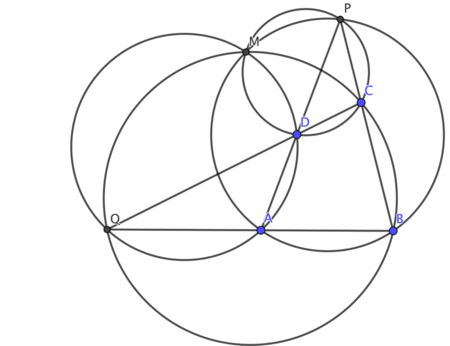
Spiral similarity is a plane transformation in mathematics composed of a rotation and a dilation.[1] It is used widely in Euclidean geometry to facilitate the proofs of many theorems and other results in geometry, especially in mathematical competitions and olympiads. Though the origin of this idea is not known, it was documented in 1967 by Coxeter in his book Geometry Revisited.[2] and 1969 - using the term "dilative rotation" - in his book Introduction to Geometry.[3]
The following theorem is important for the Euclidean plane:
Any two directly similar figures are related either by a translation or by a spiral similarity.[4]
(Hint: Directly similar figures are similar and have the same orientation)
YouTube Encyclopedic
-
1/5Views:3091 0971 9051 541439
-
Spiral Similarity and Miquel Points - A Basic Introduction
-
Spiral Similarity
-
Symmedian - Spiral Similarity Application
-
Olympiad Geometry Problem #96: Spiral Similarities
-
Spiral Similarity by Ananda Bhaduri - Unofficial IMOTC 2022
Transcription
Definition
A spiral similarity is composed of a rotation of the plane followed a dilation about a center with coordinates in the plane.[5] Expressing the rotation by a linear transformation and the dilation as multiplying by a scale factor , a point gets mapped to
On the complex plane, any spiral similarity can be expressed in the form , where is a complex number. The magnitude is the dilation factor of the spiral similarity, and the argument is the angle of rotation.[6]
Properties
Two circles

Let T be a spiral similarity mapping circle k to k' with k k' = {C, D} and fixed point C.
Then for each point P k the points P, T(P)= P' and D are collinear.
Remark: This property is the basis for the construction of the center of a spiral similarity for two linesegments.
Proof:
, as rotation and dilation preserve angles.
, as if the radius intersects the chord , then doesn't meet , and if doesn't intersect , then intersects , so one of these angles is and the other is .
So P, P' and D are collinear.
Center of a spiral similarity for two line segments
Through a dilation of a line, rotation, and translation, any line segment can be mapped into any other through the series of plane transformations. We can find the center of the spiral similarity through the following construction:[1]
- Draw lines and , and let be the intersection of the two lines.
- Draw the circumcircles of triangles and .
- The circumcircles intersect at a second point . Then is the spiral center mapping to
Proof: Note that and are cyclic quadrilaterals. Thus, . Similarly, . Therefore, by AA similarity, triangles and are similar. Thus, so a rotation angle mapping to also maps to . The dilation factor is then just the ratio of side lengths to .[5]
Solution with complex numbers
If we express and as points on the complex plane with corresponding complex numbers and , we can solve for the expression of the spiral similarity which takes to and to . Note that and , so . Since and , we plug in to obtain , from which we obtain .[5]
Pairs of spiral similarities
For any points and , the center of the spiral similarity taking to is also the center of a spiral similarity taking to .
This can be seen through the above construction. If we let be the center of spiral similarity taking to , then . Therefore, . Also, implies that . So, by SAS similarity, we see that . Thus is also the center of the spiral similarity which takes to .[5][6]
Corollaries
Proof of Miquel's Quadrilateral Theorem
Spiral similarity can be used to prove Miquel's Quadrilateral Theorem: given four noncollinear points and , the circumcircles of the four triangles and intersect at one point, where is the intersection of and and is the intersection of and (see diagram).[1]
Let be the center of the spiral similarity which takes to . By the above construction, the circumcircles of and intersect at and . Since is also the center of the spiral similarity taking to , by similar reasoning the circumcircles of and meet at and . Thus, all four circles intersect at .[1]
Example problem
Here is an example problem on the 2018 Japan MO Finals which can be solved using spiral similarity:
Given a scalene triangle , let and be points on segments and , respectively, so that . Let be the circumcircle of triangle and the reflection of across . Lines and meet again at and , respectively. Prove that and intersect on .[5]
Proof: We first prove the following claims:
Claim 1: Quadrilateral is cyclic.
Proof: Since is isosceles, we note that thus proving that quadrilateral is cyclic, as desired. By symmetry, we can prove that quadrilateral is cyclic.
Claim 2:
Proof: We have that By similar reasoning, so by AA similarity, as desired.
We now note that is the spiral center that maps to . Let be the intersection of and . By the spiral similarity construction above, the spiral center must be the intersection of the circumcircles of and . However, this point is , so thus points must be concyclic. Hence, must lie on , as desired.
References
- ^ a b c d Chen, Evan (2016). Euclidean Geometry in Mathematical Olympiads. United States: MAA Press. pp. 196–200. ISBN 978-0-88385-839-4.
- ^ Coxeter, H.S.M. (1967). Geometry Revisited. Toronto and New York: Mathematical Association of America. pp. 95–100. ISBN 978-0-88385-619-2.
- ^ Coxeter, H.S.M. (1969). Introduction to Geometry (2 ed.). New York, London, Sydney and Toronto: John Wiley & Sons. pp. 72–75.
- ^ Coxeter, H.S.M. (1967). Geometry Revisited. Mathematical Association of America. p. 97]. ISBN 978-0-88385-619-2.
- ^ a b c d e Baca, Jafet (2019). "On a special center of spiral similarity". Mathematical Reflections. 1: 1–9.
- ^ a b Zhao, Y. (2010). Three Lemmas in Geometry. See also Solutions































































































